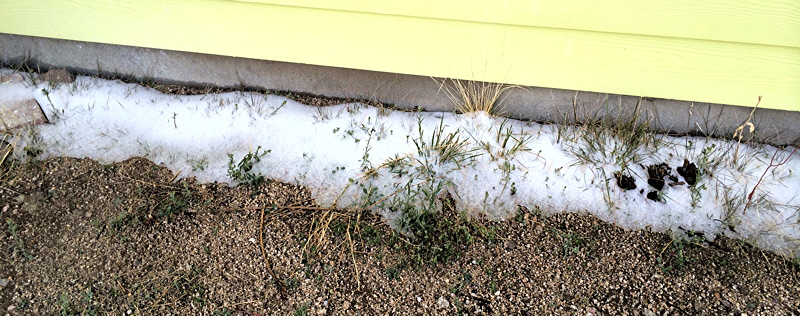
Lunar Craters Aristillus and Autolycus
Posted: 9 March 2014
Finally had some productive clouds! Got 0.55" of much needed rain 1-2 March. Woke up Sunday morning, 2 March, to some unexpected snow even though the air temperature didn't get below 39°F:

But the start of March was much like most of February: cloudy skies. Finally on Saturday, 8 March 2014, the sky cleared enough to open the observatory.
|
Opened: Saturday, 8 March 2014, 1815 MST Temperature: 67°F |
Session: 659 Conditions: Mostly clear, breezy |
1823 MST: Viewed the nearly first quarter moon, 83X. Then Jupiter; three moons were visible. Sunset was at 1826 MST. Switched to 222X on Jupiter; seeing not very good.
SYNCed observatory clock to WWV (5 MHz). Viewed the moon, 222X, and did a terminator tour. The ejecta pattern around the crater Aristillus looked impressive.
1846 MST: Tried to observe Sirius B (the "Pup Star") with the sky still somewhat bright, 222X. No luck; seeing just not good enough.
Returned to observing the moon, 222X. 1854 MST: noticed that the just barely visible Earthlit portion of the moon was approaching a star. Decided to watch the occultation. 190519 MST: star gone.
Took this handheld afocal photo of the craters Aristillus (top) and Autolycus (bottom), 222X, using the iPhone 5s:

The image above was cropped to show just the visible portion of Mare Imbrium.
1926 MST: Clouds increasing in the east. Began setting up for lunar imaging with the D7000 DSLR using eyepiece projection (222X). Took this photo at 1933 MST, "Hat Trick", ISO 400:

Mouseover or tap to see labels
1942 MST: More clouds now. Took a last look at the moon, 83X.
Slewed to M82 galaxy to check on supernova SN2014j using 83X. Wow, it really has faded. Had to use averted vision to pick it up.
Due to the clouds and moon, began closing up for the night.
|
Closed: Saturday, 8 March 2014, 2002 MST Temperature: 55°F |
|
Comments are welcome using Email. If you are on Twitter you can use the button below to tweet this report to your followers. Thanks.
Cassiopeia Observatory Home Page